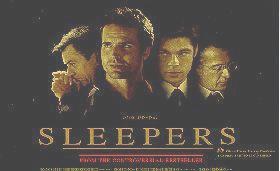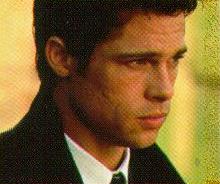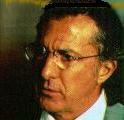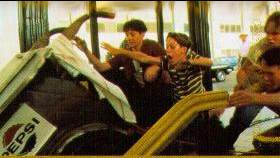click for new |
 |
| Festivale Spring 1996 |
| Casting The First Stone , a review of Sleepers. Directed by Barry Levinson There is a disclaimer in the opening credits of Sleepers that "Dialogue and certain events and characters contained in the film were created for the purposes of dramatization.". |  |
| With any film "based on true events"
one assumes that some liberty has been taken with the truth. For a film to openly state this implies on the one hand that the story is fundamentally true, but also taints the story with the possibility that it is fundamentally fictional.
I was keen to find out some of the details of Lorenzo Carcaterra's book, to see if it was obvious what was changed. I was interested to find that even a cursory glance at his book shows it to be heavily influenced by Hollywood films of the 1930s about reform schools, prisons and Hell's Kitchen, were Sleepers is set. But I was disturbed to find that some of the liberties taken with Carcaterra's story (which purports to be true), are openly manipulative. The influence of the Hollywood films about reformatories is shown both in the book, which opens its chapters with quotes from films like Angels with Dirty Faces, to the structure of the film of Sleepers.
|
| Sleepers takes this old genre, of a story of brutalisation within a reformatory, and adds a topical interest by telling a story of paedophile abuse. However, where the film departs from the book is that the boys incarcerated in the reform school are much younger in the film.
In Carcaterra's book, the characters are on the verge of adulthood, nearly 17 years old, while the film has them several years younger, barely fourteen. This tampering enforces a tabloid image of paedopilia as literally child (prepubescent) sex. This both make the abuse itself more horrific (the boys are much smaller than their abusers), and makes the revenge more acceptable. The film does not wish to present the boys as already sexual beings when sent to reform school, since it would introduce a shade of grey to what is a depressingly black and white moral landscape. The structure of the film, which compares the boy's childhood to America's childhood, and thus the paedophilic abuse the boys experience is responsible not only for their own damaged loss of innocence, but symbolic for America's as well. Moreover, the resolution the film proposes is not to clean up systemic abuse, nor simple christian forgiveness, but harsh old testament revenge. |

| It is this which makes Sleepers such a depressing
film. For it wastes the talents of some of the finest actors in American cinema on a film which gives them little scope to explore characterisation. The characters in the film are stereotypes, from the manly priest Father Bobby (Robert De Niro playing Spencer Tracy)
to the Hoodlum with a heart of gold (Vittorio Gassman) to the sadistic warden (Kevin Bacon, who at least has the opportunity to make Nokes a particularly nasty and memorable villain). Brad Pitt is perhaps the hardest done by, given the role of the obsessed lawyer Michael, who never once considers the damage that hatred is doing to him.
|
|
In the moral universe which Sleepers proposes, being a victim of paedophilia justifies not only murder, but perverting the course of justice, and even worth a priest lying on oath. Father Bobby is presented as literally the good father, yet he seems to never have given the boys in his care even the most basic tutoring in the christian concept of forgiveness.
When Father Bobby is asked to commit perjury to get his boys off the hook, he never seems to question the boy's need for revenge, only whether the crime of sending them to prison for their revenge justifies him committing a lesser crime. Father Bobby occupies a Hollywood universe, in which the teachings of Christ do not seem to play much part in Catholicism. He never once suggests that the boys need to learn how to forgive their tormentors, never once suggests that becoming consumed by hatred damages them as much as the abuse which caused that hatred. |
| The aim of the revenge is not to ensure that such abuse never happens again, nor that compensation can be made for other victims, but seemingly that they can recover their lost Eden, an imagined childhood which has been destroyed not by their own brutal parents, not by their foolish thuggery which puts them in the home, but by the paedohilia they experience in the home. The Sleepers end the film to the tune of their favourite Four Seasons song, Walk Like a Man. Sadly, none of them will ever do any more than walk like a man. They will never achieve an adult response, it seems, to anything. | 
|
| This is perhaps the ultimate weakness of Sleepers, that it does not explore the damage that the abuse has wreaked on the boys. There is enough of an alternative narrative available to suggest a much more interesting film. The sad epilogue which summarises the lives of the main participants after the events shown indicates that none of these characters learn to live with their history.
With such a wealth of acting talent, a much more complex story exploring their emotional lives could have been developed. instead, Sleepers is not much more than an elaborate revenge film, and one wonders why it needed De Niro, Pitt, Hoffman et al to tell this tale. John Dillane (November, 1996)
see also Ali Kayn's review
|
Like us on facebook | Just the facts:
Sleepers
The Players: Kevin Bacon, Robert De Niro, Dustin Hoffman, Jason Patric, Brad Pitt | |||
|
For session times of current films, use the cinema listings on the Movie links page. For scheduled release dates, see the coming attractions section. For more information about this movie, check out the internet movie database. For the latest additions to Festivale, check out the change history section. |
For the latest additions to Festivale, check out the change history section.
No other uses are permitted without the prior written consent of owner. Use of the material in violation of the foregoing may result in civil and/or criminal penalties. Celebrate everything! www.festivale.info ISSN 1328-8008 Published in Melbourne, Victoria, Australia disclaimers | contact the editor | Festivale revision history  Published in Melbourne, Victoria, Australia Published in Melbourne, Victoria, Australia  copyright © Festivale 2009 All rights reserved copyright © Festivale 2009 All rights reservedFiled: 7 Nov-1996 Entire site refreshed: Dec 2008-Feb 2009 | Site URL transferred: Jan 2005 (previously www.festivale.webcentral.com.au) |


